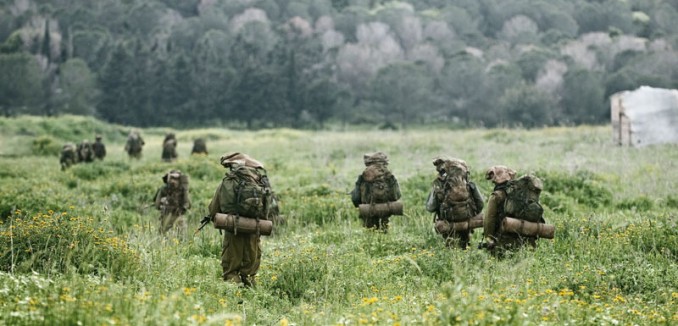With the weather warming and the anemones in full bloom, talk has turned once more to the possibility of a summer war between Israel and Hamas in the Gaza Strip. While renewed hostilities only three years after the last round are seen by some as inevitable, there are still many reasons for restraint on both sides. But the IDF has not been idle. At the forefront of its preparations is the expansion of one unit in particular, the Special Operations Engineering Unit, referred to by its acronym Yahalom—“diamond” in Hebrew.
In any future conflict in Gaza, it will be the soldiers of Yahalom who will, in a literal sense, take the lead. Among other delicate missions, they will be tasked with going below ground to fight inside Hamas’ vast tunnel network.
The man tasked with getting Yahalom ready for the next war is the unit’s head of training, a lieutenant colonel we will simply call O., in accordance with army protocol. Sitting in his office at a sprawling army base in central Israel, O. made clear from the start that things have changed dramatically since 2014’s Operation Protective Edge. Despite sending a massive ground force of three divisions into the cramped coastal territory, the IDF found itself lacking the one specialty it sorely needed: elite engineering commandos. Lessons were learned, and Yahalom was expanded from a simple battalion into a brigade-size force, with an ultimate plan to triple the size of the unit. O. stated with pride that Yahalom conducted ten times as many operations in 2016 than any prior year, no small feat for a unit that has existed since Israel’s founding in 1948.
As the name implies, Yahalom is part of the IDF’s Combat Engineering Corps. Conducting sabotage and disarming minefields and other explosive ordnance were its first assignments. In later years, elements of the unit would establish IDF beachheads across the Suez Canal and lead infantry and armored advances into enemy territory. After a 1995 hostage rescue operation went awry, a further breaching specialization was created.
These days, Yahalom’s dizzying array of operational responsibilities provides the perfect microcosm of the challenges of modern warfare.
The unit still focuses on its traditional missions. There are the sappers, who are experts at disarming all manner of explosives. There is a reconnaissance sub-unit called Yael (“Ibex”) that clears paths for ground advances in addition to pinpoint structural demolitions—think terrorist arrest operations in the West Bank. Another Yahalom sub-unit is tasked with locating and destroying hidden enemy locales like underground tunnels or weapons caches in false walls. A new sub-unit, Sayfan, has been established in the last three years to deal with the growing threat of unconventional weapons, in particular from Syria. As O. put it, “The loss of control [in Syria] over what was there could lead to arms seeping to any anonymous terror group.” This gas-masked sub-unit, he said, is on-call across Israel and can respond to any incident in 30 minutes.
Finally, there is the Samur (“weasel”) unit, assigned to dealing with the Gaza tunnels. O. is training these commandos to fight Hamas deep underground in constricted spaces with little oxygen and less light. Like much else about Yahalom, the precise details of this work remain shrouded in secrecy. O. did say that Samur members have to learn a wide range of skills, such as rappelling down into tunnels as a team, deploying robots and other classified technological systems, and destroying tunnel openings.
More than anything, this unit will likely have to fight. As a result, O. explained, they are supplied with handguns and specially-tailored light arms like Micro-Tavor assault rifles with heavy bullets to cut down the risk of ricochets off concrete walls. Blast sounds and gun fumes are accentuated in such an environment. In some cases hand-to-hand combat will be required, a point O. did not shy away from. He noted with pride that Yahalom took first place in a recent IDF-wide Krav Maga competition. “I want my fighter to be equally deadly without a weapon as he is with a weapon,” O. said, “aggressive and strong.”
The question obviously needs to be asked: what kind of soldier gets roped into a job that may include handling explosives, charging into chemical weapons, and engaging Hamas fighters in the subterranean depths?
“Look, they’re all volunteers,” O. explained. “They risk their lives more, the operations are more intensive. But the motivation is high. We want to be the spear tip.” Culled from the ranks of the larger Combat Engineering Corps and other elite units’ training programs, as well as conscripts with backgrounds in robotics, there is no one profile of a Yahalom soldier—save perhaps one. Speaking about the sappers, but just as easily about the entire unit, O. said simply, “People like it, they’re addicted to dealing with danger.” If the threats facing Israel are any indication, there will be no shortage of danger for Yahalom to deal with in the coming years—and in Gaza, perhaps even sooner than that.
Neri Zilber is a journalist and researcher on Middle East politics and culture, an adjunct fellow of the Washington Institute for Near East Policy, and a research associate of the Rubin Center at the IDC Herzliya. You can follow him on Twitter @NeriZilber.
[Photo: IDF Spokesperson Unit]




